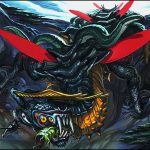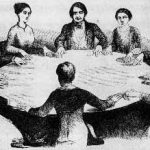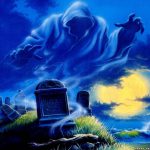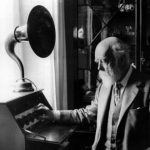The ancient Egyptians used a device similar to the ouija board. A ring was attached to a strand of thread, held over a circular table with symbols on it, and the ring would strike the table to spell out answers.
The earliest known patent for a talking board in the patent offices in London, England was filed by Adolphus Theodore Wagner, a professor of music and resident of Berlin of the Kingdom of Prussia. Wagner described his device as a “PSYCHOGRAPH, OR APPARATUS FOR INDICATING PERSONS THOUGHTS BY THE AGENT OF NERVOUS ELECTRICITY” on January 23, 1854. This patent goes on to describe the device and identify it as a talking board.
“The apparatus consists of a combination of rods or pieces of wood joined so as to permit of free action in all parts. From one of the legs of the instrument hangs a tracer; on one or more of the other extremities is fixed a disc, upon which the operator is to place his hand, and from this extremity or these extremities depends another tracer. The other parts of the apparatus consist of a glass slab or other non-conductor, and of an alphabet and set of figures or numerals. Upon a person possessing nervous electricity placing his hand upon one of the discs the instrument will immediately work, and the tracer will spell upon the alphabet what is passing in the operator’s mind.”
In 1861 a Frenchman, Allan Kardec, described ouija boards (or talking boards) in his Le Livre des Mediums thusly:1
“In order to render spirit-communications independent of the medium’s mind, various instruments have been devised. One of these is a sort of dial -plate, on which the letters of the alphabet are ranged like those on the dial of the electric telegraph; a moveable needle, set in motion through the medium’s influence, with the aid of a conducting thread and pulley, points out the letters. We cannot help thinking, however, that the independence of the medium’s thought is insured as well by the raps, and that this independence is proved more conclusively by the unexpectedness and pertinence of the answers, than by all the mechanical contrivances yet invented for this purpose. Moreover, the incredulous, always on the lookout for wires and machinery, and are more inclined to suspect deception in connexion with any special mechanical arrangements than with a bare table, devoid of all accessories.
“A more simple contrivance, but one open to abuse, as we shall see in the chapter on Frauds, is the one devised by Madame Emile de Girardin, and by which she obtained numerous and interesting communications; for that lady accomplished and clever as she was, had the weakness to believe in spirits and their manifestations. The instrument alluded to consists of a little table with a moveable top, eighteen inches in diameter, turning freely on an axle, like a wheel. On its edge are traced, as upon a dial plate, the letters of the alphabet, the numerals, and the words “yes” and “no.” In the centre is a fixed needle. The medium places his fingers on this table, which turns and stops when the desired letters is brought up under the needle. The letters thus indicated being written down one after the other words and phrases are obtained, often with great rapidity.
“It is to be remarked that the top of the little table does not turn round under the fingers, but that the fingers remain in their place and follow the movement of the table. A powerful medium might probably obtain an independent movement; in which case the experiment would be more conclusive, because less open to the possibility of trickery.”
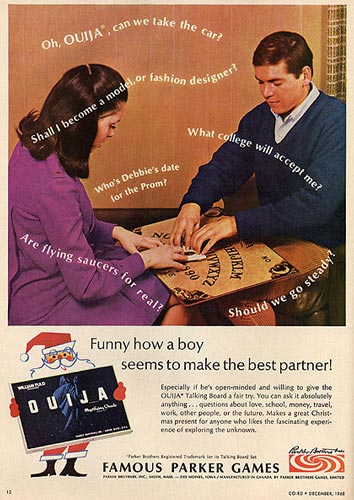 Ouija came about as kind of a by-product of the whole spiritualist movement that was all the rage in the early 1900’s. Table-tipping was being done back then, and a Frenchman, who’s last name was "planchette", produced a device that looked like a small table like a ouija pointer, that stood on two small stilts and a pen or pencil at the third point. The operator would sit with his hands as lightly as he could resting on the planchette, this device named after it’s inventor, and the thing would move, producing writing.
Ouija came about as kind of a by-product of the whole spiritualist movement that was all the rage in the early 1900’s. Table-tipping was being done back then, and a Frenchman, who’s last name was "planchette", produced a device that looked like a small table like a ouija pointer, that stood on two small stilts and a pen or pencil at the third point. The operator would sit with his hands as lightly as he could resting on the planchette, this device named after it’s inventor, and the thing would move, producing writing.
Ouija replaced the messy planchette (the writing was messy cursive scrawls) when a board was used in place of the sheet of paper, and all three stilts on the planchette were covered with felt enabling it to slide in any direction. This made the communications fast, clear, and easy.
Pearl Curran, a housewife from St. Louis, began using a friend’s ouija board in 1913. The ouija board began to spell out communications that were purportedly from a spirit contact by the name of Patience Worth. Pearl and Patience then began collaborating via automatic writing, and their output was prodigious: Patience "dictated" over a million words of poetry, plays and novels to Mrs. Curran. The works were of sufficiently high literary quality to be published and to enjoy some success among readers, and were rich in historical detail.
The Ouija board, the kind we see in toy stores today, came about in 1889 when William Fuld of Baltimore, Maryland, and his brother Isaac, marketed Ouija boards to the American public. They had a small operation and the board was the hottest item they would ever produce. People bought the board not as a game, but as a device with which they would talk to their loved ones killed in battle during the two world wars. Around 1960 Parker Brothers approached the two Fuld brothers since they were having trouble making enough boards to satisfy the demand for them. PB then took over the rights. In the 70s, the Ouija was not popular any more and the Parkers close their operation.

